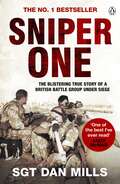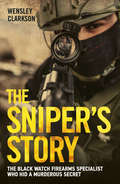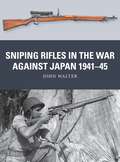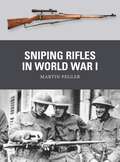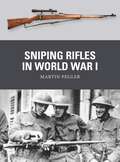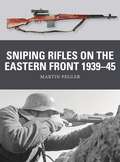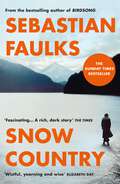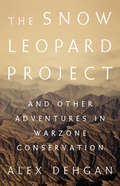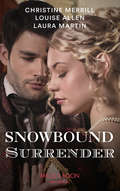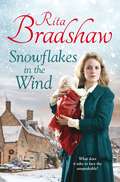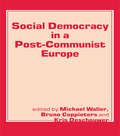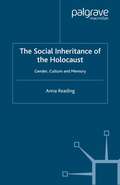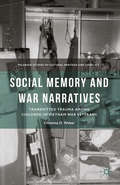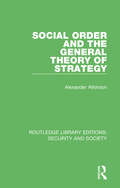- Table View
- List View
Sniper One: The Blistering True Story of a British Battle Group Under Siege
by Dan MillsSniper One is the gritty, awe-inspiring true story that takes you right into the heart of the Iraq war from Sunday Times No.1 bestseller Sgt. Dan Mills. At this special price NOW . . . 'One of the best first-hand accounts of combat that I've ever read' Andy McNabWe all saw it at once. Half a dozen voices screamed 'Grenade!' simultaneously. Then everything went into slow motion. The grenade took an age to travel through its 20 metre arc. A dark, small oval-shaped package of misery the size of a peach ...April 2004: Dan Mills and his platoon of snipers fly into southern Iraq, part of an infantry battalion sent to win hearts and minds. They were soon fighting for their lives.Back home we were told they were peacekeeping. But there was no peace to keep. Because within days of arriving in theatre, Mills and his men were caught up in the longest, most sustained fire fight British troops had faced for over fifty years.This awe-inspiring account tells of total war in throat-burning winds and fifty-degree heat, blasted by mortars and surrounded by heavily armed militias. For six months, they fought alone: isolated, besieged and under constant enemy fire. Their heroic stand a modern-day Rorke's Drift.**************Dan Mills served for 24 years as an Infantry Soldier reaching the rank of Warrant Officer Class 2. During his long military career he served on operations in Northern Ireland, Bosnia, Kosovo, Iraq and Afghanistan. Dan was awarded a 'Mention In Despatches' for Gallantry for his services during The Iraq War. Since leaving the Army in 2010, he has forged a career as a writer and security consultant, amongst other things. Sniper One is his first book.
Sniper Rifles: From the 19th to the 21st Century (Weapon)
by Peter Dennis Martin PeglerA technical outline of the history of the sniper rifle, from its introduction in warfare during the Napoleonic wars, through the US Civil War to its current apogee as the most frequently used combat rifle in Iraq and Afghanistan. This book details the development of ammunition, different weapons types including single shot, magazine loading and semi-automatic, as well as the introduction and use of optical sights. Martin Pegler, a leading expert on the history of sniping and former Senior Curator of Firearms at the Royal Armouries Leeds, also details the current advances in technology, such as laser range-finding sights and night vision devices. Using first-hand accounts, the book brings the dangerous world of the sniper to life revealing their training and concealment techniques as well as their mastering of their weapon of choice.
Sniper Rifles: From the 19th to the 21st Century (Weapon #6)
by Peter Dennis Martin PeglerA technical outline of the history of the sniper rifle, from its introduction in warfare during the Napoleonic wars, through the US Civil War to its current apogee as the most frequently used combat rifle in Iraq and Afghanistan. This book details the development of ammunition, different weapons types including single shot, magazine loading and semi-automatic, as well as the introduction and use of optical sights. Martin Pegler, a leading expert on the history of sniping and former Senior Curator of Firearms at the Royal Armouries Leeds, also details the current advances in technology, such as laser range-finding sights and night vision devices. Using first-hand accounts, the book brings the dangerous world of the sniper to life revealing their training and concealment techniques as well as their mastering of their weapon of choice.
The Sniper's Story: The Black Watch firearms specialist who hid a murderous secret
by Wensley ClarksonLocated in the bleak and desolate Orkney Islands, THE SNIPER'S STORY twists and turns through a harsh, windswept environment where secrets thrive and a member of the community can seemingly get away with murder. THE SNIPER S STORY will tell for the first time the truth about one of Britain s most bizarre and chilling crimes, as well as examining in depth, that age old question; Are Some People Born To Kill?
Sniping Rifles in the War Against Japan 1941–45 (Weapon #88)
by John WalterFully illustrated, this absorbing study explores the evolving sniping technology and tactics employed by both sides in Asia and the Pacific during 1941–45. During World War II, both the Japanese and their Allied opponents made widespread use of snipers armed with a variety of rifles, scopes and accessories and prepared by widely differing levels of training and tactical doctrine. The challenges of fighting in a variety of harsh environments, from the Pacific islands to the vast expanses of China, prompted improvisation and innovation on both sides in the ongoing war between snipers and their adversaries. Often operating at relatively close ranges in restrictive terrain, snipers made particularly ingenious use of camouflage and deception as the fighting spread across Asia and the Pacific in the wake of the Pearl Harbor attack, while troops tasked with countering enemy marksmen had to learn the hard way how best to defeat a seemingly invisible enemy. Small arms expert John Walter considers the strengths and limitations of the rifles, scopes and accessories deployed by Japanese snipers and their Allied counterparts, as well as their different approaches to sniping tactics and training. Specially commissioned artwork and carefully chosen photographs illustrate this enthralling study of the sniping war in Asia and the Pacific during World War II.
Sniping Rifles in the War Against Japan 1941–45 (Weapon #88)
by John WalterFully illustrated, this absorbing study explores the evolving sniping technology and tactics employed by both sides in Asia and the Pacific during 1941–45. During World War II, both the Japanese and their Allied opponents made widespread use of snipers armed with a variety of rifles, scopes and accessories and prepared by widely differing levels of training and tactical doctrine. The challenges of fighting in a variety of harsh environments, from the Pacific islands to the vast expanses of China, prompted improvisation and innovation on both sides in the ongoing war between snipers and their adversaries. Often operating at relatively close ranges in restrictive terrain, snipers made particularly ingenious use of camouflage and deception as the fighting spread across Asia and the Pacific in the wake of the Pearl Harbor attack, while troops tasked with countering enemy marksmen had to learn the hard way how best to defeat a seemingly invisible enemy. Small arms expert John Walter considers the strengths and limitations of the rifles, scopes and accessories deployed by Japanese snipers and their Allied counterparts, as well as their different approaches to sniping tactics and training. Specially commissioned artwork and carefully chosen photographs illustrate this enthralling study of the sniping war in Asia and the Pacific during World War II.
Sniping Rifles in World War I (Weapon)
by Martin PeglerWhile Germany and Austria-Hungary were well-equipped with sniping rifles in 1914, their Allied opponents were not. This highly illustrated volume tells the inside story of the rifles carried by snipers of all the major powers during World War I.Although military sharpshooting had existed since the 18th century, in 1914 only the German and Austro-Hungarian armies fielded trained snipers armed with scoped rifles. Thus upon the outbreak of World War I, the Allied armies found themselves on the receiving end of a shooting war to which they had no means of response. Only the Canadians brought a dedicated sniping rifle into the trenches, but in small numbers. For the British, although production of a suitable rifle and scope were settled on quickly, the establishment of sniper training was difficult and its success was mostly due to the efforts of a handful of dedicated officers. The French eventually introduced a competent scoped rifle and a sniper training system, as did the Italians. Entering the war in 1917, the Americans experienced rifle shortages but were able to build on their pre-1914 efforts to find a suitable sniping weapon. The country that suffered most grievously was Russia; Russian troops fielded no snipers at all and suffered accordingly. Featuring full-colour artwork, carefully chosen archive images and photographs of the sniping rifles and accessories used in the trenches, this is the inside story of the rifles carried by snipers of all the major powers during World War I.
Sniping Rifles in World War I (Weapon)
by Martin PeglerWhile Germany and Austria-Hungary were well-equipped with sniping rifles in 1914, their Allied opponents were not. This highly illustrated volume tells the inside story of the rifles carried by snipers of all the major powers during World War I.Although military sharpshooting had existed since the 18th century, in 1914 only the German and Austro-Hungarian armies fielded trained snipers armed with scoped rifles. Thus upon the outbreak of World War I, the Allied armies found themselves on the receiving end of a shooting war to which they had no means of response. Only the Canadians brought a dedicated sniping rifle into the trenches, but in small numbers. For the British, although production of a suitable rifle and scope were settled on quickly, the establishment of sniper training was difficult and its success was mostly due to the efforts of a handful of dedicated officers. The French eventually introduced a competent scoped rifle and a sniper training system, as did the Italians. Entering the war in 1917, the Americans experienced rifle shortages but were able to build on their pre-1914 efforts to find a suitable sniping weapon. The country that suffered most grievously was Russia; Russian troops fielded no snipers at all and suffered accordingly. Featuring full-colour artwork, carefully chosen archive images and photographs of the sniping rifles and accessories used in the trenches, this is the inside story of the rifles carried by snipers of all the major powers during World War I.
Sniping Rifles on the Eastern Front 1939–45 (Weapon)
by Martin PeglerThe Soviet Union had developed a significant sniping force by 1939, but the extraordinary skill and cunning displayed by Finnish snipers during the Winter War forced the Soviets to innovate. On the other side, German sniping suffered from a lack of standardization of weapons and a lack of marksmen deployed at the start of the Great Patriotic War (1941–45). There were few heroes in the conflict, but on both sides, the snipers were idolized – especially on the Soviet side, gaining almost mythical status.As well as traditional bolt-action weapons, both sides used several types of semi-automatic rifle, such as the SVT-38 and the Gew 41. Offering greater firepower at the expense of long-range accuracy, such weapons would be profoundly influential in the postwar world. Fully illustrated, this absorbing study investigates the development of sniping weapons and techniques on World War II's Eastern Front.
Sniping Rifles on the Eastern Front 1939–45 (Weapon #67)
by Martin PeglerThe Soviet Union had developed a significant sniping force by 1939, but the extraordinary skill and cunning displayed by Finnish snipers during the Winter War forced the Soviets to innovate. On the other side, German sniping suffered from a lack of standardization of weapons and a lack of marksmen deployed at the start of the Great Patriotic War (1941–45). There were few heroes in the conflict, but on both sides, the snipers were idolized – especially on the Soviet side, gaining almost mythical status.As well as traditional bolt-action weapons, both sides used several types of semi-automatic rifle, such as the SVT-38 and the Gew 41. Offering greater firepower at the expense of long-range accuracy, such weapons would be profoundly influential in the postwar world. Fully illustrated, this absorbing study investigates the development of sniping weapons and techniques on World War II's Eastern Front.
Snow and Steel: Battle of the Bulge 1944-45
by Peter Caddick-AdamsSnow and Steel will be a huge reassessment of Hitler's last great throw of the dice: 'The Battle of the Bulge', the battle for the Ardennes 16 December 1944 to 25 January 1945. This is an utterly fascinating five weeks when for a time it looked like Hitler had outflanked the allied armies pushing toward the Rhine and might just throw them back to the Normandy beaches. It is also the context for the catastrophic events at Bastogne depicted so graphically in Band of Brothers.For military history fans this is one of those touchstone battles of the second world war, written by an author with a fast growing, world-wide reputation. Peter will use primary archival material and personal interviews to write a controversial, commercial, landmark book.
Snow Country: SUNDAY TIMES BESTSELLER
by Sebastian FaulksThe epic new novel from the bestselling author of Birdsong'Wistful, yearning and wise' Elizabeth Day1914: Aspiring journalist Anton arrives in Vienna where he meets Delphine, a woman of deep secrets. Anton is entranced by the light of first love, until his country declares war on hers. 1927: For Lena, life in a small town has been cosseted and cold. When her love affair with a young lawyer crumbles, she leaves to take a post at the snow-capped sanatorium, the Schloss Seeblick. 1933: Anton is sent to write about the mysterious Schloss Seeblick. In this place, on the banks of a silvery lake where the roots of human suffering are laid bare, two people will see each other as if for the first time.'Fascinating... A rich, dark story' The Times
The Snow Leopard Project: And Other Adventures in Warzone Conservation
by Alex DehganThe remarkable story of the heroic effort to save and preserve Afghanistan's wildlife-and a culture that derives immense pride and a sense of national identity from its natural landscape.Postwar Afghanistan is fragile, volatile, and perilous. It is also a place of extraordinary beauty. Evolutionary biologist Alex Dehgan arrived in the country in 2006 to build the Wildlife Conservation Society's Afghanistan Program, and preserve and protect Afghanistan's unique and extraordinary environment, which had been decimated after decades of war.Conservation, it turned out, provided a common bond between Alex's team and the people of Afghanistan. His international team worked unarmed in some of the most dangerous places in the country-places so remote that winding roads would abruptly disappear, and travel was on foot, yak, or mule. In The Snow Leopard Project, Dehgan takes readers along with him on his adventure as his team helps create the country's first national park, completes the some of the first extensive wildlife surveys in thirty years, and works to stop the poaching of the country's iconic endangered animals, including the elusive snow leopard. In doing so, they help restore a part of Afghan identity that is ineffably tied to the land itself.
The Snow Leopard Project: And Other Adventures in Warzone Conservation
by Alex DehganThe remarkable story of the heroic effort to save and preserve Afghanistan's wildlife-and a culture that derives immense pride and a sense of national identity from its natural landscape. Postwar Afghanistan is fragile, volatile, and perilous. It is also a place of extraordinary beauty. Evolutionary biologist Alex Dehgan arrived in the country in 2006 to build the Wildlife Conservation Society's Afghanistan Program, and preserve and protect Afghanistan's unique and extraordinary environment, which had been decimated after decades of war. Conservation, it turned out, provided a common bond between Alex's team and the people of Afghanistan. His international team worked unarmed in some of the most dangerous places in the country-places so remote that winding roads would abruptly disappear, and travel was on foot, yak, or mule. In The Snow Leopard Project, Dehgan takes readers along with him on his adventure as his team helps create the country's first national park, completes the some of the first extensive wildlife surveys in thirty years, and works to stop the poaching of the country's iconic endangered animals, including the elusive snow leopard. In doing so, they help restore a part of Afghan identity that is ineffably tied to the land itself.
Snowbound Surrender: Their Mistletoe Reunion / Snowed In With The Rake / Christmas With The Major (Mills And Boon Historical Ser.)
by Laura Martin Louise Allen Christine MerrillStay snowed-in this Christmas… …with these three Regency short stories!
Snowflakes in the Wind
by Rita BradshawSnowflakes in the Wind is a heartwarming story of triumph over adversity by Rita Bradshaw, author of the number one bestselling Dancing in the Moonlight.It's Christmas Eve 1920 when nine-year-old Abby Kirby's family is ripped apart by a terrible tragedy. Leaving everything she's ever known, Abby takes her younger brother and runs away to the tough existence of the Border farming community.Years pass. Abby becomes a beautiful young woman and falls in love, but her past haunts her, casting dark shadows. Furthermore, in the very place she's taken refuge is someone who wishes her harm.With her heart broken, Abby decides to make a new life as a nurse. When the Second World War breaks out, she volunteers as a QA nurse and is sent overseas. However, life takes another unexpected and dangerous turn when she becomes a prisoner of the Japanese. It is then that Abby realizes that whatever has gone before is nothing compared to what lies ahead . . .
Social Democracy in a Post-communist Europe
by Bruno Coppieters Kris Deschouwer Michael WallerThis book examines the fortunes of social democracy since 1989 in the former GDR, Poland, Hungary, the Czech Republic and Slovakia, setting the analysis in a broader European framework, and relating the current problems of social democracy in western Europe to developments in the east of the continent.
Social Democracy in a Post-communist Europe
by Michael Waller Bruno Coppieters Kris DeschouwerThis book examines the fortunes of social democracy since 1989 in the former GDR, Poland, Hungary, the Czech Republic and Slovakia, setting the analysis in a broader European framework, and relating the current problems of social democracy in western Europe to developments in the east of the continent.
Social Formations in the Medieval World: From Roman Civilization till the Crisis of Feudalism
by Rakesh KumarThis book encapsulates a period of history of human progress by highlighting crucial social, economic, and cultural dynamics. It presents recent historiography and new analytical tools used to analyse multi-dimensional themes involved in social formation. This is a reader-friendly book with simple and lucid language and fulfils the pressing needs of students studying the paper ‘Social Formations and Cultural Patterns of Ancient and Medieval World’ at various universities across the world. The summary, keywords, and representative questions at the end of each chapter would assist in revision and better understanding of the issues dealt therein. A detailed chapter-end reference would enable and motivate the readers to engage in further studies for better understanding of the themes.This book will be of interest to students, researchers, and academics in the area of history—ancient and medieval world history in particular and anthropology. It will also be an interesting read for general readers interested in knowing about the ancient and medieval world.
Social Formations in the Medieval World: From Roman Civilization till the Crisis of Feudalism
by Rakesh KumarThis book encapsulates a period of history of human progress by highlighting crucial social, economic, and cultural dynamics. It presents recent historiography and new analytical tools used to analyse multi-dimensional themes involved in social formation. This is a reader-friendly book with simple and lucid language and fulfils the pressing needs of students studying the paper ‘Social Formations and Cultural Patterns of Ancient and Medieval World’ at various universities across the world. The summary, keywords, and representative questions at the end of each chapter would assist in revision and better understanding of the issues dealt therein. A detailed chapter-end reference would enable and motivate the readers to engage in further studies for better understanding of the themes.This book will be of interest to students, researchers, and academics in the area of history—ancient and medieval world history in particular and anthropology. It will also be an interesting read for general readers interested in knowing about the ancient and medieval world.
The Social Inheritance of the Holocaust: Gender, Culture and Memory
by A. ReadingThis book challenges current thinking on memory by examining the complex ways in which the social inheritance of the Nazi Holocaust is gendered. It considers how the past is handed down in the US, Poland and Britain through historiography, autobiographies, documentary and feature films, memorial sites and museums. It explores the configuration of socially inherited memories about the Holocaust in young people of different cultural backgrounds. Scholarly and accessible, the book provides a groundbreaking approach to understanding the significance of gender in relation to cultural mediations of history.
Social Memory and War Narratives: Transmitted Trauma among Children of Vietnam War Veterans (Palgrave Studies in Cultural Heritage and Conflict)
by C. WeberThe Vietnam War has had many long-reaching, traumatic effects, not just on the veterans of the war, but on their children as well. In this book, Weber examines the concept of the war as a social monad, a confusing array of personal stories and public histories that disrupt traditional ways of knowing the social world for the second generation.
Social Order and the General Theory of Strategy (Routledge Library Editions: Security and Society)
by Alexander AtkinsonIs there a place left in international politics for the real use of violence as an instrument of policy in the nuclear age? Originally published in 1981, Dr Atkinson attempts to answer this question with new considerations in the presentation of a general theory of strategy. He argues that the classical theory of strategy, so influential for the 19th century and for the better half of the 20th century, was built on a mainly hidden structure of reasoning that still infests theory today. The larger and socially-rooted lessons that insurgent warfare can inform, as best exemplified in the primary sources of the Chinese Civil War period, reveal in a new light this hidden structure of which Clausewitz is the earliest and most eloquent example. By this analysis of the insurgent and classical paradigm opposites the author intends to strip away the blinds of convention still circulating in theory today so that observers and students of international politics may see where new forms of politically motivated violence in the nuclear age seem more than ever to be headed. Here we have perfect paradigm opposites. In the conventional world battle-field action and ideally 'decisive battle' is the center of all other issues in which such conventional logic in the end sweeps up everything else and runs it back through the logic into success or failure of armed power on the battle-field. Everything hangs on this. In the 'revisionist' insurgent world where social order is weaponized as an object and source of military power through its inherent and valuable (armed) power structures social order replaces narrow battle-field action (ideally focused on 'decisive battle') and alternatively redirects the entire logic and all other considerations, including previously heroic conventional military assets, are remodeled to act against (armed) enemy power structures inherent (as always) in social order for the ultimate object of military victory. Again, everything is on this alone. Which paradigm - one the opposite mirror image of the other - will prevail will depend on the stability and power of the nation state and its institutions, the continued and unhappy collapse on which I base the General Theory.
Social Order and the General Theory of Strategy (Routledge Library Editions: Security and Society)
by Alexander AtkinsonIs there a place left in international politics for the real use of violence as an instrument of policy in the nuclear age? Originally published in 1981, Dr Atkinson attempts to answer this question with new considerations in the presentation of a general theory of strategy. He argues that the classical theory of strategy, so influential for the 19th century and for the better half of the 20th century, was built on a mainly hidden structure of reasoning that still infests theory today. The larger and socially-rooted lessons that insurgent warfare can inform, as best exemplified in the primary sources of the Chinese Civil War period, reveal in a new light this hidden structure of which Clausewitz is the earliest and most eloquent example. By this analysis of the insurgent and classical paradigm opposites the author intends to strip away the blinds of convention still circulating in theory today so that observers and students of international politics may see where new forms of politically motivated violence in the nuclear age seem more than ever to be headed. Here we have perfect paradigm opposites. In the conventional world battle-field action and ideally 'decisive battle' is the center of all other issues in which such conventional logic in the end sweeps up everything else and runs it back through the logic into success or failure of armed power on the battle-field. Everything hangs on this. In the 'revisionist' insurgent world where social order is weaponized as an object and source of military power through its inherent and valuable (armed) power structures social order replaces narrow battle-field action (ideally focused on 'decisive battle') and alternatively redirects the entire logic and all other considerations, including previously heroic conventional military assets, are remodeled to act against (armed) enemy power structures inherent (as always) in social order for the ultimate object of military victory. Again, everything is on this alone. Which paradigm - one the opposite mirror image of the other - will prevail will depend on the stability and power of the nation state and its institutions, the continued and unhappy collapse on which I base the General Theory.
The Social Roots of American Politics: A Widening Gyre?
by Byron E. Shafer Regina L. WagnerA novel and powerful explanation of the social roots of American politics and the powerful forces in the background. The usual approach to political conflict is to look at policy battles inside government, then trace them back to political parties and organized interests. Yet, in The Social Roots of American Politics, Regina L. Wagner and Byron E. Shafer begin at the opposite end of the causal chain by looking at the social roots of American political conflict, how these roots produce differing policy preferences in the general public, and how those preferences get transmitted into American government. Drawing from over a half-century of public surveys of American voters, they demonstrate that class, race, religion, and gender provide the roots of these conflicts across the four primary domains of policy conflict: social welfare, civil rights, foreign affairs, and cultural values. They also factor in how regional differences affect partisan attachment, focusing on the South in particular. By turning the focus to deep-rooted social cleavages, this book provides a novel and powerful explanation of the basic forces that shape the contours of conflict in American politics.
